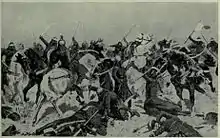Second Battle of Tarain
The Second Battle of Tarain was fought in 1192 by the Ghurids against the Chahamanas and their allies, near Tarain (modern Taraori in Haryana, India). The Ghurid king Mu'izz al-Din defeated the Chahamana king Prithiviraj Chauhan thus avenging his earlier defeat at the First Battle of Tarain.
| 2nd Battle of Tarain | |||||||||
|---|---|---|---|---|---|---|---|---|---|
 A 20th-century artist's imagination of the battle from Hutchinson's Story of the Nations | |||||||||
| |||||||||
| Belligerents | |||||||||
| Ghurid Empire | Chahamanas of Shakambhari | ||||||||
| Commanders and leaders | |||||||||
| Mu'izz al-Din | Prithviraj Chauhan | ||||||||
| Strength | |||||||||
| 120,000 (according to Minhaj)[1][2] |
300,000 cavalry and infantry,[lower-alpha 1] 2,000[4] - 3,000 War elephants | ||||||||
Background
Prithviraj Chauhan's forces had defeated the Ghurids at the First Battle of Tarain in 1191. The Ghurid king Mu'izz al-Din, who was seriously injured in the battle, returned to Ghazni, and made preparations to avenge his defeat.
Historians generally date the second battle of Tarain to 1192, although there is a possibility that it happened in late 1191.[5]
Size of the forces
According to the 16th-17th century writer Firishta, the battle, "the Chauhan army consisted of 3,000 elephants, 300,000 cavalry and infantry", which is considered an exaggeration by modern historians. According to Satish Chandra the figures were exaggerated in order to "emphasise the challenge faced by Muizzuddin and the scale of his victory".[3] Kaushik Roy similarly notes that Muslim chroniclers regularly exaggerated Hindu military strength to glorify the Muslim kings, and 300,000 was probably the theoretical number that could potentially be mobilized by all the Hindu kingdoms at the time.[2]
According to Minhaj-i-Siraj, Mu'izz al-Din brought 120,000 fully armored men to battle,[1] He personally commanded an elite cavalry force of 40,000 men. According to historian Kaushik Roy, while the real strength of the armies is not certain, it can be speculated that Prithviraj's army was numerically superior.[2]
Battle
The battle occurred in the same field as the first one. Knowing the Chahamana forces were well-disciplined, the Ghurids did not want to engage in melee combat with them. Instead the Ghurids army was formed into five units, and four units were sent to attack the enemy flanks and rear.[6]
According to Minhaj, Mu'izz ad-Din directed a light cavalry force of 10,000 mounted archers, divided into four divisions, to surround the Chahamana forces on the four sides.[7] He instructed these soldiers not to engage in combat when the enemy advanced to attack, and instead feign retreat in order to exhaust the Chahamana elephants, horses, and infantry.[8]
In hopes of causing a break in the enemy lines, Mu'izz al-Din ordered his fifth unit to feign retreat. The Chahamana forces charged the fleeing Ghurid unit, as the Ghurids expected. The Ghurids then sent a fresh cavalry unit of 12,000 and they managed to throw back the enemy advance. The remaining Ghurid forces then attacked and the Chahamana troops fled in panic.[6] According to Minhaj, Mu'izz ad-Din's strategy "exhausted and wearied the unbelievers", ultimately resulting in a "victory to Islam".[8]
Aftermath
Minhaj states that Prithviraj ("Rae Pithora") dismounted from his elephant, and fled from the battlefield on a horse. He was, however, captured in the neighbourhood of Sursuti, and later "dispatched to hell".[8] Most medieval sources state that Prithviraj was taken to the Chahamana capital Ajmer, where Muhammad planned to reinstate him as a Ghurid vassal. Sometime later, Prithviraj rebelled against Muhammad, and was killed for 'treason'.[9]
The Ghurid forces subjugated the entire Chahamana territory of "Siwalikh"[8] (or Sawalakh, that is, Sapadalaksha).[10] The Ghurids then appointed his son Govindaraja IV on the throne of Ajmer as their vassal. Prithviraj's younger brother Hariraja dethroned Govindaraja, and recaptured a part of his ancestral kingdom, but was later defeated by the Ghurid general Qutb al-Din Aibak.[11] The Ghurids subsequently defeated another powerful king - Jayachandra of Gahadavala dynasty - at the Battle of Chandawar, and conquered parts of northern India as far as Bengal.[6]
See also
- Battles fought in Rajasthan
References
- Satish Chandra 2006, p. 25.
- Kaushik Roy 2014, pp. 22-23.
- Satish Chandra 2006, pp. 25-26.
- Kaushik Roy 2004, p. 40.
- Cynthia Talbot 2015, p. 44.
- Spencer C. Tucker 2009, p. 263.
- Cynthia Talbot 2015, p. 47.
- Cynthia Talbot 2015, p. 48.
- Dasharatha Sharma 1959, p. 87.
- Cynthia Talbot 2015, p. 33.
- Dasharatha Sharma 1959, pp. 100–01.
Bibliography
- Cynthia Talbot (2015). The Last Hindu Emperor: Prithviraj Cauhan and the Indian Past, 1200–2000. Cambridge University Press. ISBN 9781107118560.CS1 maint: ref=harv (link)
- Dasharatha Sharma (1959). Early Chauhān Dynasties. S. Chand / Motilal Banarsidass. ISBN 9780842606189.CS1 maint: ref=harv (link)
- Kaushik Roy (2004). India's Historic Battles: From Alexander the Great to Kargil. Orient Longman.CS1 maint: ref=harv (link)
- Kaushik Roy (2014). Military Transition in Early Modern Asia, 1400-1750: Cavalry, Guns, Government and Ships. Bloomsbury. ISBN 978-1-78093-800-4.
- Satish Chandra (2006). Medieval India: From Sultanat to the Mughals-Delhi Sultanat (1206-1526). Har-Anand. ISBN 978-81-241-1064-5.CS1 maint: ref=harv (link)
- Spencer C. Tucker (2009). A Global Chronology of Conflict: From the Ancient World to the Modern Middle East. ABC-CLIO. ISBN 978-1-85109-672-5.CS1 maint: ref=harv (link)